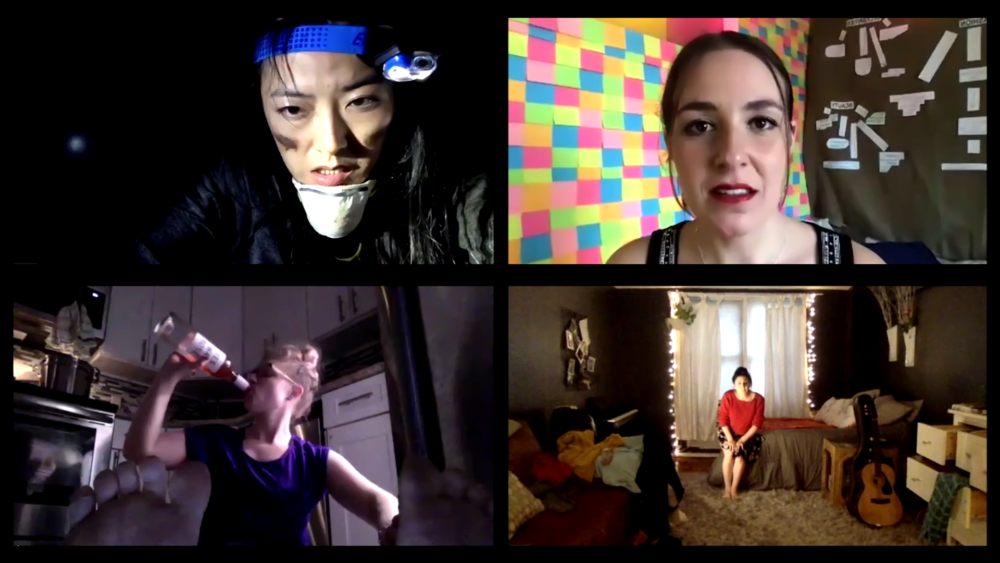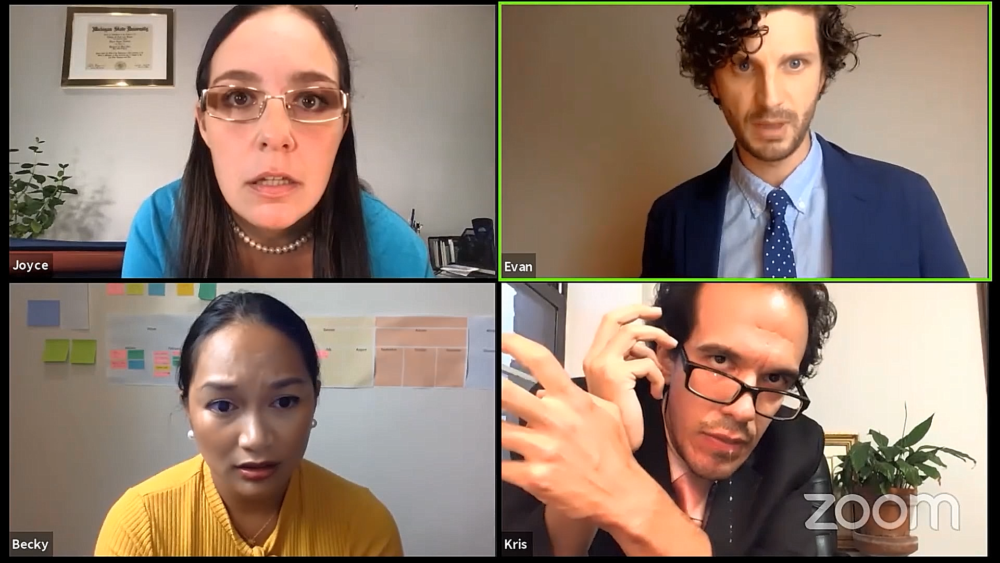Greenhouse Ensemble takes the Zoom Challenge
by Marcina Zaccaria
Following a six year tradition, Greenhouse Ensemble scheduled an evening of 10-15 minute short plays. Taking the blues out of the quarantine experience, artists presented six new plays from over 300 submissions. Prior to the COVID crisis, the 6th Soiree was to be scheduled at The Tank, the location where former plays were performed.
Artistic Director Hazen Cuyler shared his thoughts with Marcina Zaccaria (Interviewer at TheaterPizzazz.com) about live plays on Zoom, performance through traumatic experience and his upcoming talk at CANDID.

MZ: What do you think about new play production in the age of video conferencing? Has it changed the way that you make theater?
HC: I love it. I don’t think Zoom/conference-call-theatre is theatre. And I don’t think it’s television or film, either. I think it’s an amazing hybrid of live film. There are a few good things to have come out of this terrible blip in history, and I think this form of art might be one of them. I don’t know that it has changed the way I make theatre, but while we’re quarantined from each other, it certainly forces every actor to create a theater inside their apartment.
This new medium presents many challenges that promote creative problem solving which is very fertile ground from which art can grow. Our Quarantine Soiree plays are not written for Zoom. So, the initial challenge becomes justifying why you’re showing multiple perspectives at once. Sometimes, a literal Zoom conversation can be implied in the circumstances and then you just need to worry about separate environments for each character. Other times, like the most recent production I directed, Running in Circles Screaming, backgrounds need to be matched for characters to appear to be in the same location together. Then, the cameras are justified in a more traditional film perspective. Running in Circles Screaming is set on a playground park bench, and I wanted a very realistic look, so we shot outside at two similar looking locations. One was in Los Angeles at 4pm and another in Michigan at 7pm. The lighting (miraculously) was similar, and we didn’t need to haul out very practical lighting equipment (household lamps, etc.) to balance the two locations.
Another production, this time a very playful and quick-witted comedy, also took place in a park. Because of the nature of the piece, the director wanted a more self-aware, playful atmosphere. He chose to use green screens for each actor, placing more absurd, frozen images in the background. There are countless unexpected and sometimes tedious technical challenges (ex. uprooting your entire living situation to get the right lighting) you must work through, but there are clear benefits.
First, it’s live. There’s still intense pressure and anything can go wrong (and while in its infancy, much does). That sense of danger adds to the excitement and supports the immediacy of the work, even if actors aren’t directly feeding off the audience’s energy. A benefit for the audience is the heightened level of intimacy. One of my favorite elements of this new form is when an actor looks directly into the camera while speaking to another character. In film and television, actors and directors have been so shy about looking directly into the camera for fear it alienates audiences, but for some reason, it is powerful and it works here.
The platform also provides a rare opportunity to work with artists from around the world. In the few episodes of our Quarantine Soirée on Zoom, we’ve worked with artists from Mexico, Portugal, England, Canada, Greece and from all over the United States. Zoom has shown us just how accessible we are to each other. And how alike we are in our methods and desires to create art.
I hope when quarantine is over this live film idea will continue. I hope this trend of connecting artists around the world continues. I hope this new medium continues because it allows the essence of theatre to become more accessible to audiences who may rarely step inside a darkened auditorium.
MZ: How did you remain in communication with your ensemble and regular audience attendees?
HC: We used the void of quarantine life as an excuse to create necessary structures for our ensemble. We had a weekly ensemble training session already. But we added an hour of daily technique. Our writers group has continued, we hired a consulting firm to work on our business structure and we added, of course, this new Quarantine Soirée on Zoom.
Additionally, we began rehearsals and productions on two films shot remotely (one with puppets). We already had another film in post-production, shot prior to the pandemic, so we had that responsibility as well. By creating structures for our artists to fall into, we cultivated a great deal of creative energy over a short period of time.
Regarding our audiences – with our Quarantine Soirée, we not only connect with our New York City audiences on a much more regular basis, but are able to share our work with new audiences across the country and around the world. It’s amazing to read a message from someone in Greece telling us how moved they were by a play we produced from Michigan with one actress in Mexico, another in NYC, and a designer in London.


MZ: What other steps did Greenhouse Ensemble take, so far, to survive the pandemic? As an Artistic Director, have you been giving advice?
HC: It was clear at the very beginning, to me, that this was a time for growth for myself and for all our artists. Some people needed time to adjust to the new normal, but very quickly, most of us jumped into work. Reanna, our Managing Director, lost her grandmother unexpectedly at the start of the pandemic (not COVID related). So aside from the trauma we were all experiencing in NYC, she quickly understood that added tragedy of loss faced by millions of family members.
Neil Gaiman gave advice during a commencement speech in 2012, and I’ll paraphrase to avoid butchering his words, but basically his message was to make good art all the time, regardless of circumstance, but especially when facing challenges or even tragedy. Shakespeare wrote King Lear when in quarantine and Michael Chekhov described himself having to consciously absorb the tragedy of his father’s death in order to play Lear. My advice to the artists I work with is to make art during all times. Reanna’s grandmother passed away during the rehearsal process of our first film shot in quarantine. I believe her work in that project channels some of the inescapable and fearful frustration we all felt at the beginning of this pandemic – desperately looking down a tunnel and unable to detect light.
The process of creating art is an act of healing the individual and the community at large. By becoming more sensitive to your own suffering and sharing what you’ve understood, you transmit that knowledge to audiences and relieve their suffering.
MZ: How did you get the opportunity to speak at CANDID? Might you give us an indication of what you’re planning to say?
HC: Arts month at CANDID is an amazing opportunity for anyone in the theatre or arts community in NYC. They provide unparalleled resources and information which can transform any organization. The like-minded people who go to these events are always beneficial to meet. So, I feel truly fortunate to have been asked back again.
This will be the third year in a row that I’ll be speaking at CANDID. I was asked to attend because Joey Guastella, who runs the programming for their arts month, is a supporter of Greenhouse. Joey sees more theatre than anyone I know – he’s a voter for The Drama League and sees theatre all over the world all the time. It’s an honor that he appreciates our work.
When he first asked me to talk, two years ago, the first thing I said was, “Great! But I haven’t the slightest idea what you want me to say.” He suggested I speak about Greenhouse and our community and how we create work. That idea evolved into a passionate appeal to theatre companies and artists in the independent theater community to work together, put aside our petty competitive urges and recognize the wealth of resources at our disposal.
Last year at CANDID, I continued down a more practical path of similar ideology, discussing the beginning stages of a theater and arts district in Manhattan. Regardless of the pandemic, that district is still in the making.
This year, I’ll be sitting on a panel discussing how we move forward while in this new, distanced phase of theatre. I’ll be with two incredible panelists- Julie Crosby and Bonnie J. Monte. Julie is a founding partner of Cromono International, and has been written up in Forbes’ “40 Over 40 watchlist.” Bonnie J. Monte has been The Artistic Director of The Shakespeare Theater in New Jersey for 30 years.
As you might have noticed, I’m a bit optimistic about the way theatre companies are creating work within the pandemic, so I will likely encourage theatres and artists to refine and appreciate this new medium opposed to treating it as an irritating phase we’re stuck in.
I think this is an amazing time in the history of all art. I believe, for the arts at least, this Zoom theatre/live film is the new medium which theatre has been driving toward for many years (most recently in West Side Story directed by Ivo Van Hove and Medea directed by Simon Stone). It is a separate medium which needn’t be competitive with theatre or film. When we find a way to iron out the obvious technical kinks, the potential reach for theatre arts (in American audiences anyway) could be revolutionary.
Every Thursday Night at 7pm on Facebook Live. All episodes are available on The Greenhouse Ensemble’s YouTube page

















